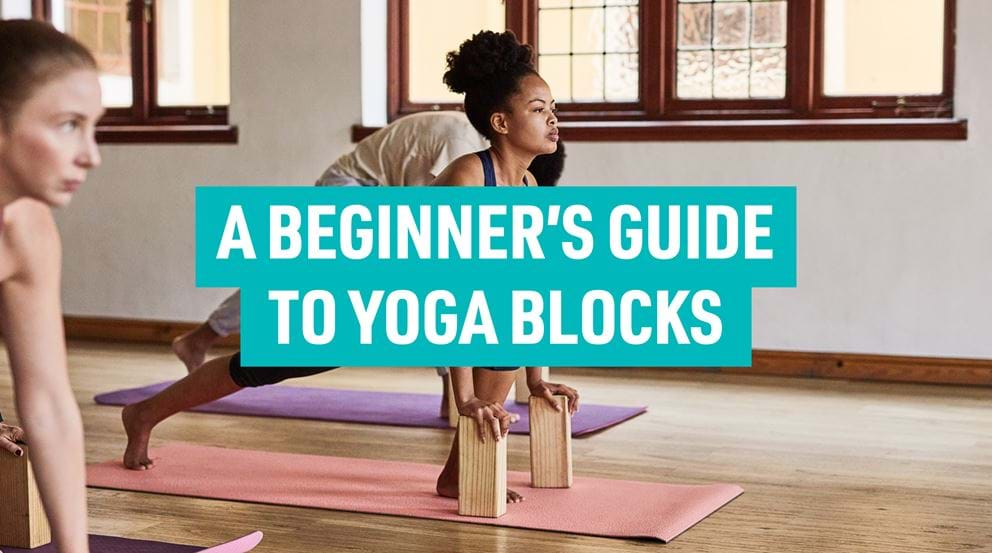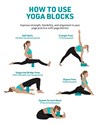How To Use Yoga Blocks: The Ultimate Guide

What Are Yoga Blocks | What Are The Benefits | How To Use Blocks | What Size | Modified Poses
Looking for ways to improve your yoga practice? Yoga blocks are a useful tool that can help to improve flexibility and strength for both yoga beginners and those who have been practising for some time.
Some people prefer to avoid props in their yoga practice, thinking that it might hinder them, but using yoga blocks can help to advance your yoga faster than without.
In this blog, PureGym Glasgow Clydebank PT and Yoga Instructor Steph Williams looks at what are the benefits of yoga blocks, ways to use yoga blocks in your practice, and some examples of yoga block exercises to try in your next practice.
What Are Yoga Blocks?
Yoga blocks are typically rectangular blocks made of foam, cork, or wood. Coming in different sizes, they are a prop that can be used during your practice to modify poses and provide support, stability, and balance.
Yoga blocks are used to modify poses and are helpful for beginners who may not have the flexibility or strength to perform certain poses on their own. Using the blocks to support various parts of the body, such as hands, feet, hips, and back, helps to achieve proper alignment and form during yoga practice. This means the correct muscles are engaged and stretched, allowing for faster progress.
It’s not just beginners who can benefit from using blocks in yoga. Yoga blocks can also be used to make poses more challenging, for example by allowing someone to go deeper into a pose.
What Are the Benefits of Using Yoga Blocks?
Yoga blocks offer several benefits to yoga practitioners, including:
-
Improved flexibility
Yoga blocks can help to increase flexibility by allowing practitioners to achieve a safe stretch with correct alignment, and then gradually deepen this over time. Using blocks to create space in poses can increase the benefits, even in simple poses such as Sukhasana where placing block under the hips increases height and creates length in the spine.
-
Increased strength
Practising yoga with blocks helps to strengthen the muscles by encouraging correct alignment, which means the intended muscles are engaged with an appropriate amount of tension. This leads to improved overall strength and endurance as the muscle adapts to these conditions over time.
-
Better balance and support
Blocks can help to improve balance and stability during challenging poses by providing a grounding foundation. For example, a block can be used in Ardha Chandrasana (half moon pose) for support, reducing strain on the shoulders and allowing focus to be on correct alignment.
-
Accessibility
Blocks can be used to modify poses, making them more accessible for practitioners who may have physical limitations or injuries. For example, it can be useful to place blocks under your hands to bring the ground ‘up towards’ you to allow more space in certain poses like Parsvottasana (pyramid pose).
Overall, using yoga blocks can enhance the yoga practice and help practitioners to achieve their goals while reducing the risk of injury and improving accessibility in certain poses.
Yoga Block Uses
Yoga blocks can be used in several ways depending on the pose it’s being used in, and the reason it’s being used.
Some common ways to use yoga blocks are:
-
Improve support and stability
Placing a block under the hands or feet can provide support and stability during traditional foundational poses such as Adho Mukha Svanasana (downward facing dog).
Using blocks in this way also creates more space in the body to allow better form and can take the pressure off joints like the wrists by decreasing the gap between the hands and floor.
-
Increase height
A common way yoga blocks are used is to increase the height of the floor to make poses more accessible when flexibility or balance is a limiting factor. Using a block allows you to focus on form and breathwork rather than struggling to access or maintain the pose.
-
Modification
Yoga blocks can modify poses to make them more accessible or challenging. For example, place a block under your hip in Eka Pada Rajakapotasana (pigeon pose) creates more space under the hips, allowing those who lack hip mobility to access the pose. On the other hand, using blocks in Anahtasana (puppy pose) creates more space to allow a deeper stretch, helping to advance the pose for those with more flexibility.
-
Alignment
Blocks can help to achieve proper alignment and form in poses where you rely on flexibility rather than muscle engagement to get into position. For example, placing a block between your thighs can help activate the muscles of your inner thighs and improve alignment in Virabhadrasana II (warrior II), or holding a block between the elbows in Bakasana (crow pose) to ensure you are engaging the chest and triceps.
-
Restorative poses
Use blocks to support the body in restorative poses makes these poses more passive, helping to relieve tension. For example, using a block under the lower back in Setu Bandha Sarvangasana (supported bridge pose) or between the shoulders in Matsyasana (fish pose).
Yin yoga is a restorative style of yoga which uses props like yoga blocks, bolsters, and blankets in this way. You can learn more about yin and other types of yoga here.
What Size Yoga Block Should I Use?
Yoga blocks come in different sizes, and each block can be turned onto different edges to increase or decrease the height. Choosing a height that allows proper alignment for the pose you are attempting will enhance your yoga practice and help you to achieve greater strength and flexibility.
5 Poses Using Yoga Blocks
It’s possible to use blocks with most yoga poses, but these are 5 beginner-friendly and common asanas that can be modified with yoga blocks.

-
Half splits (Ardha Hanumanasana)
Place a yoga block under your front hamstring to support your weight and help you to deepen the stretch. You can also place a block under each hand to avoid bringing your fingertips down to the floor and encourage length in the spine.
-
Triangle pose (Trikonasana)
Place a yoga block by your front foot to raise the ground, allowing you to reach more easily with the bottom hand. You can then use this to encourage a deeper spinal twist and raise your top hand to the ceiling.
-
Supported bridge pose (Setu Bandha Sarvangasana)
Create more space and provide extra support in the lower back by resting a block under your sacrum. This also makes the pose slightly more passive and helps to stretch the hips, as opposed to a regular bridge where the main focus is engaging the glutes to support the body.
-
Pigeon pose (Eka Pada Kapotasana):
Place a yoga block under the hip on your crossed leg to elevate it and help you to sink deeper into the stretch. This can also make the pose more comfortable for those who struggle with their hip mobility as it allows your hip to rest.
-
Seated forward bend (Paschimottasana)
Place a yoga block to the highest height between your shins so you can rest your forehead. This will help you to maintain a flat back and relax fully into the stretch. It can also feel relaxing to press your forehead into the block and roll it from side to side, creating a slight massage into the forehead and the temples. Some practitioners will spray lavender spray or a comforting essential oil onto their block in this pose too for a multi-sensory experience to help you decompress after a long day!
Whether you want to make poses more accessible or more challenging, yoga blocks are an excellent tool for yogis of all levels. Incorporating blocks into your practice allows you to improve alignment, engage the correct muscles, and get deeper into poses.
Looking for more yoga advice? Check out some of our favourite yoga poses for beginners here. We offer yoga at many of our gyms, find your nearest PureGym here!


